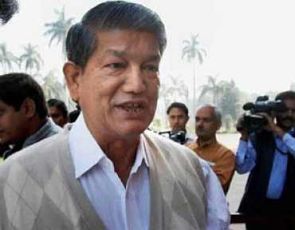 Close aides say Rawat does not give in easily and uses all political tools to marginalise his adversaries.
Close aides say Rawat does not give in easily and uses all political tools to marginalise his adversaries.
Shishir Prashant reports.
After the imposition of President's rule in Uttarakhand, ousted chief minister Harish Rawat has teamed up with the state Congress chief with the aim of winning the 2017 assembly poll.
Curiously, the Bharatiya Janata Party's state unit is in shambles, with top leaders almost absent from the scene
Guess who are the most visible people in Uttarakhand these days? Rawat, left, and state Congress President Kishore Upadhyay. Even in the media, these two leaders are hogging the limelight.
After the imposition of President's rule in the state, the political jugalbandi of the two leaders is back, the ultimate aim being to win the 2017 assembly elections. They lose no opportunity to attack the BJP and, in particular, Prime Minister Narendra Modi on different issues. It is apparent that they want to neutralise the anti-incumbency factor.
The two leaders are credited with the Congress' stunning 2002 assembly election victory at a time when it was nowhere on the political scene in the hill state. It is a different story that the Congress ignored Rawat for the chief minister's post at that time.
But in 2014, the Congress brought back both Rawat and Upadhyay, hoping to rekindle the magic they wove in 2002.
With the state BJP leadership in disarray, the two Congress leaders have launched an all-out attack against the saffron brigade. They have even declared that they are ready for elections any time now.
Even as the BJP-led government at the Centre moved the Supreme Court against the high court's decision revoking President's rule in Uttarakhand, Rawat and Upadhyay participated in scores of marches and held media conferences almost daily, targeting Modi for what they said was a 'murder of democracy.'
Ironically, the BJP has almost vanished from the scene, relying instead on spokesperson Munna Singh Chauhan to attack the Congress on various issues. State BJP President Ajay Bhatt is hardly visible in the media these days while top state party leaders, including Bhagat Singh Koshiyari and former chief ministers B C Khanduri and Ramesh Pokhriyal Nishank, are totally absent.
"It is sad that our top leaders are not ready to face the salvos being fired at the BJP by the Congress camp on a daily basis," admitted a state BJP leader.
Even on the issue of President's rule, a section of BJP leaders say the Centre did not play its cards well. Though Khanduri is still considered the best bet for the CM post in the BJP, he is not showing much interest in Uttarakhand's politics. "If you compare Khanduri and Rawat, Khanduri with his clean image is the right choice," said another BJP leader.
All is not well in the Congress camp either. Rawat is supposedly trying to outwit Upadhyay by 'meddling' in the affairs of the state party unit. Party insiders say Rawat will not give Upadhyay much space in the overall scene, as the former chief minister wants to be the sole face of the Congress in the next assembly elections.
Even after the rebellion by nine assembly members of the Congress, Rawat emerged the most powerful leader in the state party unit. Most of Rawat's rivals in the Congress, including Vijay Bahuguna and Satpal Maharaj, are out. But that also means the Congress has been weakened. Rawat has told his supporters that he has tremendous capacity to win the assembly elections.
This is not the first time a rebellion has erupted in the state Congress. Rawat had spearheaded a revolt against the Congress in 2012 after he was ignored for the top job in the hill state by the party high command. At that time, he was serving as a Union minister of state in the Manmohan Singh government at the Centre. But he chose not to leave the party.
Instead of sulking, Rawat started building his image as a suave politician appearing regularly on prime time television news. Within months, he was heading the key water resources ministry as a full-fledged Cabinet minister.
Rawat kept the heat on the Bahuguna camp. Within two years, Rawat managed to dislodge Bahuguna and fulfilled his long-cherished dream of becoming chief minister of Uttarakhand on February 1, 2014.
Close aides of Rawat admit he does not give in easily and uses all political tools to marginalise his political adversaries. This art, they say, he learnt from veteran Congress leader N D Tiwari. But in his long political journey, Rawat has seen many ups and downs.
When Uttarakhand was formed in 2000, the Congress presence in the hill state was negligible. The BJP's lotus was in full bloom. Even in the interim assembly at that time, there were just three Congress representatives in the 23-member House, against the BJP's 17.
And then came Rawat, who was chosen by the Congress high command to head the state unit and revitalise it. Rawat, with his organisational skills, started reviving the party. Within a year, he had strengthened the organisation at the block-level in such a way that the party scored an impressive win in the first assembly elections in 2002, getting a majority on its own.
The Congress' win came as a shock to the BJP which had played a major role in the formation of the hill state. And now he may not be CM, but Rawat is still a leader.











